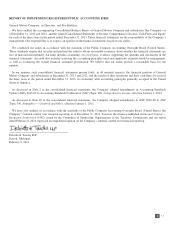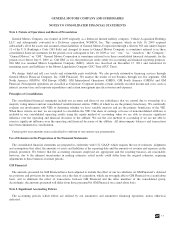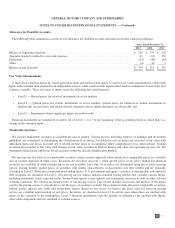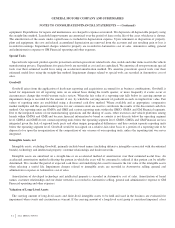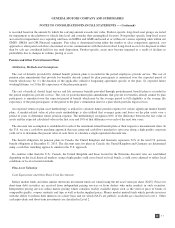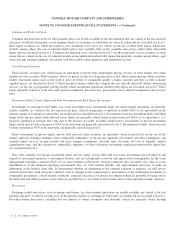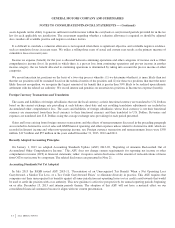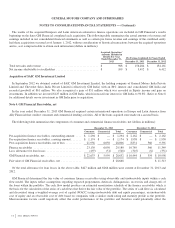General Motors 2013 Annual Report Download - page 63
Download and view the complete annual report
Please find page 63 of the 2013 General Motors annual report below. You can navigate through the pages in the report by either clicking on the pages listed below, or by using the keyword search tool below to find specific information within the annual report.
GENERAL MOTORS COMPANY AND SUBSIDIARIES
NOTES TO CONSOLIDATED FINANCIAL STATEMENTS — (Continued)
Allowance for Doubtful Accounts
The following table summarizes activity in our allowance for doubtful accounts and notes receivable (dollars in millions):
Years Ended December 31,
2013 2012 2011
Balance at beginning of period ........................................................... $ 311 $ 331 $ 252
Amounts charged (credited) to costs and expenses ........................................... 61 (10) 159
Deductions .......................................................................... (24) (46) (83)
Other ............................................................................... (4) 36 3
Balance at end of period ................................................................ $ 344 $ 311 $ 331
Fair Value Measurements
A three-level valuation hierarchy, based upon observable and unobservable inputs, is used for fair value measurements. Observable
inputs reflect market data obtained from independent sources, while unobservable inputs reflect market assumptions based on the best
evidence available. These two types of inputs create the following fair value hierarchy:
• Level 1 — Quoted prices for identical instruments in active markets;
• Level 2 — Quoted prices for similar instruments in active markets; quoted prices for identical or similar instruments in
markets that are not active; and model-derived valuations whose significant inputs are observable; and
• Level 3 — Instruments whose significant inputs are unobservable.
Financial instruments are transferred in and/or out of Level 1, 2 or 3 at the beginning of the accounting period in which there is a
change in the valuation inputs.
Marketable Securities
We classify marketable securities as available-for-sale or trading. Various factors, including turnover of holdings and investment
guidelines, are considered in determining the classification of securities. Available-for-sale securities are recorded at fair value with
unrealized gains and losses recorded net of related income taxes in Accumulated other comprehensive loss until realized. Trading
securities are recorded at fair value with changes in fair value recorded in Interest income and other non-operating income, net. We
determine realized gains and losses for all securities using the specific identification method.
We measure the fair value of our marketable securities using a market approach where identical or comparable prices are available
and an income approach in other cases. Securities are classified in Level 1 when quoted prices in an active market for identical
securities are available. If quoted market prices are not available, fair values of securities are determined using prices from a pricing
service, pricing models, quoted prices of securities with similar characteristics or discounted cash flow models and are generally
classified in Level 2. These prices represent non-binding quotes. U.S. government and agency securities, sovereign debt and corporate
debt securities are classified in Level 2. Our pricing service utilizes industry-standard pricing models that consider various inputs,
including benchmark yields, reported trades, broker/dealer quotes, issuer spreads and benchmark securities as well as other relevant
economic measures. We conduct an annual review of our pricing service. This review includes discussion and analysis of the inputs
used by the pricing service to provide prices for the types of securities we hold. These inputs include prices for comparable securities,
bid/ask quotes, interest rate yields and prepayment speeds. Based on our review we believe the prices received from our pricing
service are a reliable representation of exit prices. Securities are classified in Level 3 in certain cases where there are unobservable
inputs to the valuation in the marketplace. Level 3 financial instruments typically include, in addition to the unobservable inputs,
observable components that are validated to external sources.
61




